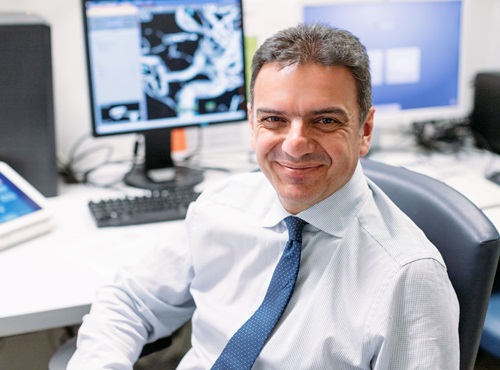
While the recently presented SEGA trial and many other studies have attempted to establish which of the two prevalent methods for medically inducing a loss of consciousness during a mechanical thrombectomy procedure is best, the neurointerventional community remains divided. Here, Panagiotis Papanagiotou (Athens, Greece/Bremen, Germany) takes a closer look at this debate.
How do you decide between general anaesthesia (GA) and conscious sedation (CS) for stroke thrombectomy? This pivotal choice can significantly impact patient outcomes and procedural efficiency. Both GA and CS have their pros and cons, and the evidence remains mixed.
Pros and cons
GA ensures complete patient immobility and secure airway management—crucial for precision in neurointerventional procedures. It allows better control over physiological variables, such as blood pressure and carbon dioxide levels, reducing intraoperative complications. However, the ideal timing for extubation post-procedure is not well-defined. Prolonged mechanical ventilation can lead to complications like pneumonia or disturbances in cerebral blood flow, while premature extubation might cause agitation, disorientation, sudden blood-pressure fluctuations, and the need for reintubation.
CS allows for a faster start to the procedure, and is associated with fewer and less severe blood-pressure fluctuations. Patients under CS are less likely to require intensive care, allowing for more efficient postoperative management. However, ensuring patient immobility can be challenging, and there is less precise control over physiological parameters.
Evidence overview
Recent studies and meta-analyses provide valuable insights, but no definitive answers. A 2023 systematic review and meta-analysis included nine randomised controlled trials (RCTs) with 1,342 patients and found no significant differences in functional outcomes—measured by the modified Rankin scale (mRS)—at three months between GA and CS, although GA was associated with higher successful reperfusion rates. The SIESTA trial reported similar findings, with GA showing higher recanalisation rates but no significant difference in early neurological outcomes. The GOLIATH trial observed higher recanalisation rates and shorter times to reperfusion with GA, but no significant differences in functional outcomes.
Additionally, a meta-analysis by Jin et al (2024) involving eight RCTs and 1,352 patients found that GA achieved higher successful reperfusion rates compared to CS but also noted a higher incidence of pulmonary infections with GA. Meyer et al (2024) analysed the effect of anaesthetic strategies on distal stroke thrombectomy, finding similar reperfusion rates between local anaesthesia (LA) with/without CS and GA for distal medium vessel occlusions (DMVOs) in the anterior and posterior cerebral arteries (ACA/PCA). However, GA showed a potential benefit in achieving complete reperfusion in ACA DMVOs.
Personal perspective
In our practice, CS is preferred as the first choice, when feasible. This approach offers several benefits, including the ability to observe clinical improvements directly during the procedure. This real-time feedback aids in the decision-making process about when to conclude the intervention based on both angiographic and clinical criteria. Additionally, patients under CS are less likely to require intensive care post-procedure, allowing for more straightforward management and the possibility of transferring the majority to a stroke unit instead. It is also very rewarding to see the enthusiasm of the staff in witnessing direct improvements in the patients’ clinical condition, which serves as a motivating factor to treat these patients.
In our centre, more than 90% of thrombectomies—both in the anterior and posterior circulations—are performed under CS. The decision between GA and CS is made just before the intervention, based on the patient’s condition and ability to cooperate. Effective communication and collaboration between the neurointerventionist and the anaesthesiologist are crucial to ensure both professionals are comfortable with the chosen approach. Observations suggest that patients with poor collateral circulation or severe aphasia may not cooperate well with CS, making GA a more suitable option in such cases.
Practical considerations
If you are starting to perform thrombectomies, it may be beneficial to begin with GA to ensure better control and stability during the angiographic process. As experience and confidence grow, transitioning to CS could offer the aforementioned benefits.
Assessing the patient’s ability to tolerate CS without significant anxiety or movement is crucial. Patients with poor collateral circulation or severe aphasia may not cooperate well, making GA a more suitable option. And, while becoming proficient in one approach is beneficial, maintaining flexibility to switch if the clinical situation warrants is essential for optimising patient outcomes.
In our experience, CS is often the preferred choice for mechanical thrombectomy, offering immediate clinical feedback and more efficient postoperative management. However, the decision between GA and CS should be individualised, considering patient-specific factors and the collaborative input of the medical team. Both techniques have their advantages and drawbacks, and ongoing research will continue to refine best practices in this area.
References:
- Powers W J, Rabinstein A A, Ackerson T et al. Guidelines for the early management of patients With acute ischemic stroke. Stroke. 2018; 49(3): e46–e110.
- Schönenberger S, Uhlmann L, Hacke W et al. Effect of conscious sedation vs general anesthesia on early neurological improvement among patients With ischemic stroke undergoing endovascular thrombectomy: a randomized clinical trial. JAMA. 2016; 316(19): 1986–96.
- Geraldini F, Diana P, Fregolent D et al. General anesthesia or conscious sedation for thrombectomy in stroke patients: an updated systematic review and meta-analysis. Can J Anaesth. 2023; 70(7): 1167–81.
- Liang F, Wu Y, Wang X et al. General anesthesia vs conscious sedation for endovascular treatment in patients With posterior circulation acute ischemic stroke: an exploratory randomized clinical trial. JAMA Neurol. 2023; 80(1): 64–72.
- Meyer L, Stracke C P, Broocks G et al. Effect of anesthetic strategies on distal stroke thrombectomy in the anterior and posterior cerebral artery. J Neurointerv Surg. 2024; 16(3): 230–6.
- Jin S, Du W, Liang D et al. General anesthesia versus sedation for endovascular thrombectomy: meta-analysis and trial sequential analysis of randomized controlled trials. Heliyon. 2024; 10(13): e33650.
Panagiotis Papanagiotou is a professor of radiology at Aretaieion University Hospital/National and Kapodistrian University (Athens, Greece), and a professor of neuroradiology and head of the Department of Diagnostic and Interventional Neuroradiology at Bremen Hospital (Bremen, Germany).
The author declared no relevant disclosures.










